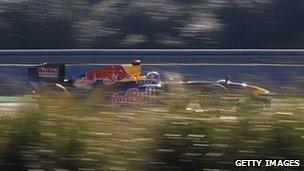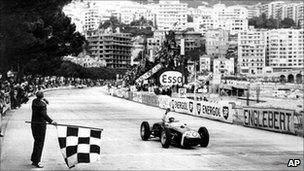Formula 1 seeks to be better by design
- Published
Circuit designer Drew MacDonald says track design is extremely important in racing.
Snaking through a former World War II airfield about an hour north of London, Silverstone race track in Northamptonshire - home to the Formula 1 British Grand Prix - has made yet another wild turn.
The circuit has already experienced some major changes in the run-up to the last F1 race there in July 2010.
But this summer, drivers and spectators will see a completely new pit lane and different positions for the start and finish lines.
And, to make sure everything is as it should be, the racing circuit designer who drastically changed the look of Silverstone is trying it out for himself.
Putting on his tight-fitting helmet he slides into a sports car.
With a roar, the car leaps forward and Drew MacDonald's face lights up with excitement.

The Australian Grand Prix will now open the season, after the Bahrain race was cancelled
"It is the first time I've been on the new track since we started changing it several months ago," says the 34-year-old from the design company Populous, visibly proud of his achievement.
This year's Formula 1 should have been due to start in Bahrain on 13 March, but, like one of the sport's circuits, is providing a few twists and turns of its own.
Instead of lining up on the grid in the Middle East the season will instead kick off on 27 March in Melbourne, Australia.
Added excitement
Meanwhile, Silverstone is ensuring it is all ready for the British Grand Prix this summer.
The changes at the track, Mr MacDonald says, will increase chances for overtaking - a hugely important aspect of racing, both for drivers, eager to cross the finish line first, and for the audience, keen on the thrill.
In a bid to improve overtaking, this coming season drivers will be able to adjust their car's rear wing while on the track, if they are within a second of the car in front and within a 600 metre zone on a straight.
It is estimated that this will help to propel the car forward and increase the chances of passing the rival ahead.
But circuit design is extremely important, too, says Mr MacDonald.
At Silverstone, the driver entering the new pit lane will be able to continue in a straight line at full speed for quite some time, while competitors will have to negotiate a slow corner on the track and inevitably slow down. With the old pits, it was the other way around.
Also, the new finish line will add some excitement, says Mr MacDonald, as it will now be positioned only about 100m from the last corner.
"It is a tricky corner for powering down, so if there are a couple of cars fighting to win, it will be much more likely that one of them will make a mistake.
"Previously, the final corner was a very easy, fast curve," he says.
Besides relocating the pit lane to the other side of the circuit, the designers have built a new pit and paddock complex that will host drivers, the media and VIP spectators.
The move is certainly meant to boost the oldest F1 track's historic popularity as one of the world's best Grand Prix circuits.
Pressure to change
But Silverstone is a circuit that basically had little choice but to invest a large sum of money into rather radical modifications.

While F1 teams fine-tune their car throughout the year, circuits do not get modified that often
Several years ago, Bernie Ecclestone, the Formula 1 commercial rights holder, criticised the home of the British Grand Prix for failing to upgrade to meet new standards, especially the quality of Silverstone's spectator facilities.
In 2009 the track's F1 future was hanging by a thread. Only when a rival, Donington Park, started to face financial difficulties, did Mr Ecclestone sign a new 17-year deal with Silverstone - as long as the circuit owners agreed to build a new paddock.
So the managers hired an army of builders and architects, with Drew MacDonald as the main circuit designer.
"The track upgrade was initiated by Silverstone's desire to host MotoGP, and the old GP circuit did not meet the current safety requirements," explains Mr MacDonald, adding that now Silverstone can host both MotoGP and F1 races.
Costly options
Formula 1 teams spend millions of dollars and countless days - and often nights - fine-tuning their cars throughout the year.
But circuit managers are more careful with their cash. Although circuits might modify their layout every now and then, major modifications are pricey and thus do not happen very often.

Spa Francorchamps in Belgium is considered to be one of the most exciting F1 circuits
At Silverstone, circuit upgrades cost about £6m, while the new building cost some £30m.
Roger Peart, president of the FIA's (Federation Internationale d'Automobile) Circuit Commission and a civil engineer, designed the famous Gilles Villeneuve circuit, venue for the F1 Canadian Grand Prix, back in 1977.
The track is located on the island of Notre-Dame in the middle of the Saint Lawrence River.
Mr Peart says changes are often made when required for safety reasons, so a crash could lead to a redesign.
For example, circuits have been widened over time to keep up to date with changing standards and changing cars, which year after year become more powerful and sophisticated, particularly in terms of the aerodynamics.
"Back 30 to 40 years ago, the standard was 10 metres wide. Now we're typically looking at 12 or even 14 metres, plus wider on the start-finish straight," says Mr Peart.
Widening the tracks also provides more opportunity for overtaking, he adds, but safety always comes first.
"There's a big difference between safety and overtaking possibilities. Safety has to be paramount," says Mr Peart.
'Boring' circuits
Over the past several months, there has been a certain amount of criticism over the design of some F1 circuits, both in regards to older tracks that might benefit from an upgrade and those that have been built very recently.
Team Lotus technical head Mike Gascoyne made headlines in early February, having called new circuits in the Middle East "boring" because of the lack of overtaking opportunities.

F1 cars have become more sophisticated, and circuits like Monaco have been modified accordingly
"Bahrain and Abu Dhabi were the two most boring races [of 2010]. It's pretty disappointing that you've got two massively boring races on circuits where you had literally carte blanche to do anything you liked," Mr Gascoyne told Reuters.
McLaren's official test driver Gary Paffett has experience of the majority of Formula 1 circuits.
He says that it is remarkably easy to tell an exciting circuit from a less interesting one.
One of the crucial attributes of the former is the right combination of "thrilling high-speed corners" that add the buzz with low-speed corners and long straights, which make overtaking possible.
"I'd say that the most exciting circuits are Spa Francorchamps [in Belgium], Istanbul mainly because of Turn 8, and also street circuits like Monaco and Singapore."
On the other hand, he says, there is Abu Dhabi, which is "very flat" with far fewer overtaking opportunities.
"People want to go to a circuit where you can race - nobody wants to go to a circuit where, after qualifying, it's just going to be a procession until the end," says Mr Paffett.
Some critics even say that the current F1 circuit "guru", Hermann Tilke, a German designer who built the majority of F1 tracks, might eventually kill all the excitement if he does not steer clear of slow twisty corners and too many straights.
But Mr Tilke brushes off such criticism. He says overtaking is a difficult procedure and should remain so.
"Often the faster race car drives in front of the slower car, which is then the reason for not overtaking and not the design of the circuit," he says.
"Some circuits allow for good overtaking opportunities. For example, the new Hockenheimring and Spa Francorchamps; these races are often exciting and entertaining for the spectators," he adds.
Tilke's 'monopoly'
Back at Silverstone, Drew MacDonald proudly walks down the yet-to-be completed pit lane.
It is his first F1 collaboration and he hopes that his company, Populous, will be asked to modify or build other Grand Prix tracks, a niche area for now almost monopolised by Tilke Engineering.
"I'm sure what we've done at Silverstone will help overtaking and will make the coming race very exciting," he says.
Soon, drivers and spectators will have the opportunity to access Mr MacDonald's changes.
Looking at the empty track that in a few months will buzz with the world's most powerful race car engines, the young designer says that he already has some ideas on how to improve some of the less interesting F1 circuits, for example the Abu Dhabi one.
"Up until recently, Tilke had no competition, so when a new country signs with Bernie Ecclestone, he introduces Tilke, because he has delivered circuits and facilities before," says Mr MacDonald.
"We're certainly noticing a change; we're bidding against him in a couple of projects. I think our job at Silverstone will make another dent in his monopoly."